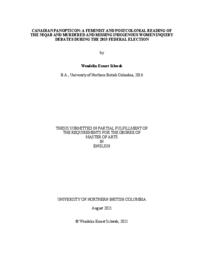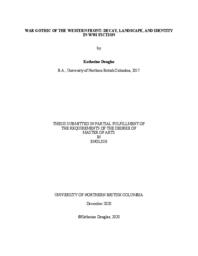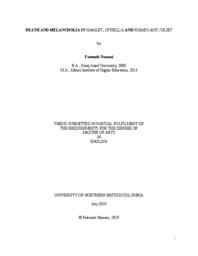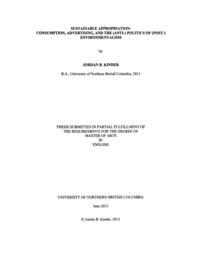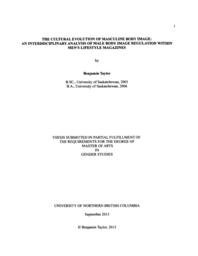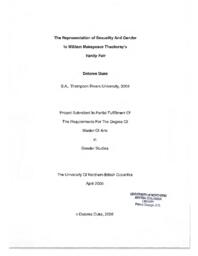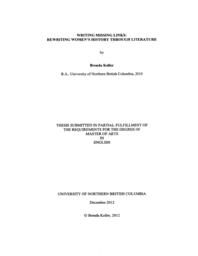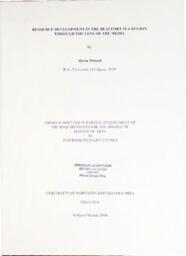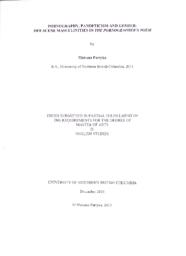Romanets, Maryna
Person Preferred Name
Maryna Romanets
Related Works
Content type
Digital Document
Description / Synopsis
This thesis explores the relationship between pornography, eroticism, and censorship, focusing on the reception of sexually explicit representations in literature and film by the public and governing bodies in their sociopolitical, cultural, and legal contexts. My comparative analysis of Marquis de Sade’s Justine (1797), its intertextual dialogist, Pauline Réage’s Story of O (1954), and their respective twentieth-century screen adaptations, by Jess Franco and Just Jaeckin, attempts to demonstrate changes in attitudes toward what once was considered to be top-shelf cultural production over time. Drawing on the intersection of cultural, feminist, film, sexuality, and pornography studies, my work examines how, and to what extent, Sade, Réage, Franco, and Jaeckin had their fair share of trouble with censorship laws, and the ways they challenge and subvert the accepted sexual norms and, by extension, then current state body politics by propagating the ideas of sexual freedom, freedom of choice, and sexual equality
Origin Information
Content type
Digital Document
Description / Synopsis
Simon’s Song is a self-reflexive creative-critical text composed of journal entries, research notes, and various other records written by fictional undergraduate student Simon Goodsworth, and compiled by an anonymous archivist. Through the organized presentation of Simon’s writings, there appears a fragmented narrative which follows Simon as he joins his university’s musical theatre club and becomes absorbed in planning and research for a Master’s thesis applying poststructuralist theory to the study of musical theatre. Simon’s research and original insights into the work of Roland Barthes, Jacques Derrida, Martin Heidegger, and Gilles Deleuze and Felix Guattari destabilize the hidden structures implicit in his perception of his self and his world. Through his writing Simon stages explorations of the ubiquity of performativity, the relationship between life and writing, and the inescapability of what Derrida calls “différance,” the precondition of language and meaning in general. Implicit in Simon’s Song is a recognition that each act of engagement with this text is an uniterable performance. Were it not for this recognition of provisionality, it would be safe to assert that Simon’s Song is, above anything else, a thesis about itself.
Origin Information
Content type
Digital Document
Description / Synopsis
Canada is a settler-colonial state that specially targets and others minority groups, such as Indigenous peoples and recent immigrants. This was no more apparent than during the 2015 federal election, which saw debates on whether to ban Muslim women from wearing niqabs and other head coverings and whether to hold an inquiry into the epidemic of missing and murdered Indigenous women. By examining excerpts from speeches, tweets, articles, and interviews made by politicians, citizens, and journalists, this thesis traces the shape of settler-colonial systems and their impact on Indigenous and immigrant women. Canadian society demands conformity to sexual and cultural norms that require walking a tightrope of these double-edged ideals. Conformity is maintained through societally enforced regimes, known as the Panopticon, where each individual is both prisoner and guard. This constant surveillance does not simply end there, however, as Canadian settler society has different gender structures and norms for both men and women: women are subject to far stricter social expectations than men and, as this thesis brings to light, women in minority groups, such as indigenous and Muslim women, fall under an even harsher Canadian spotlight.
Origin Information
Content type
Digital Document
Description / Synopsis
The First World War was a unique and unrepeatable Gothic event, and so, this thesis examines its modern and postmodern literary accounts within the War Gothic framework. Analysing Erich Maria Remarque’s All Quiet on the Western Front, Gabriel Chevallier’s Fear, Sebastian Barry’s A Long Long Way, and Joseph Boyden’s Three Day Road, it looks at the relationships of transformative states; specifically, the decomposition and destruction of the body, the landscape, identity, and masculinity along the trenches of the Western Front. Moreover, this thesis explores how the Gothic nature of WWI affects identity politics in the four novels according to personal, cultural, and national authorial subject positions. The War Gothic unites the German and French narratives with the previously unrepresented, and now re-imagined, Irish Catholic and Indigenous Canadian war experiences for the Gothic communicates the ineffable complexities of human nature and of war.
Origin Information
Content type
Digital Document
Description / Synopsis
This research explores how the body is implicated in transmuting meaning for women who are substance dependent on opioids and have engaged in survival sex work. Using a hybridized application of narrative, theorizing, and interviews, this interdisciplinary thesis identifies some of the ways these women navigate the constraints of their marginalization. Eight women were interviewed on the traditional, ancestral, and unceded territory of the Musqueam, Squamish, and Tsleil-Waututh Nations in Vancouver, British Columbia. The research works to acknowledge and explore how these women exist in an ‘alternate’ economy in order to obtain opioids to meet their life-needs. The employment of materialist feminist examinations of alienation and access to capital located shared experiences in the women’s narratives. Though the research did not reveal an explicit connection between the body, meaning, and sex work, there was a strong indication of meaning making through advocacy and engagement with those in similar social positions.
Origin Information
Content type
Digital Document
Description / Synopsis
This thesis analyzes the effects of love and melancholia on male and female characters along with their responses to melancholia which fluctuate among choler, revenge, murder, suicide, homicide, madness, never-ending mourning, and lovesickness in Hamlet, Othello, and Romeo and Juliet. My analysis draws on a composite theoretical framework that combines new historicist or cultural materialist perspectives and psychoanalytic approach, focusing on Sigmund Freud’s conceptualization of mourning and melancholia and Julia Kristeva’s meditations on depression and melancholia. Having examined these three plays in terms of their creative symptomatology revealed in the characters’ melancholic dispositions––thus viewing Shakespeare as creative symptomatologist, I arrived at establishing a range of gendered melancholic states, namely love melancholia, virgin melancholy or greensickness, and choleric melancholia. Furthermore, while in Shakespearean dramatic universe the cure for individual melancholia is administered, stereotypically, through marriage and sex,
Origin Information
Content type
Digital Document
Origin Information
Content type
Digital Document
Origin Information
Content type
Digital Document
Origin Information
Content type
Digital Document
Origin Information
Content type
Digital Document
Origin Information
Content type
Digital Document
Origin Information
Content type
Digital Document
Origin Information
Content type
Digital Document
Origin Information



